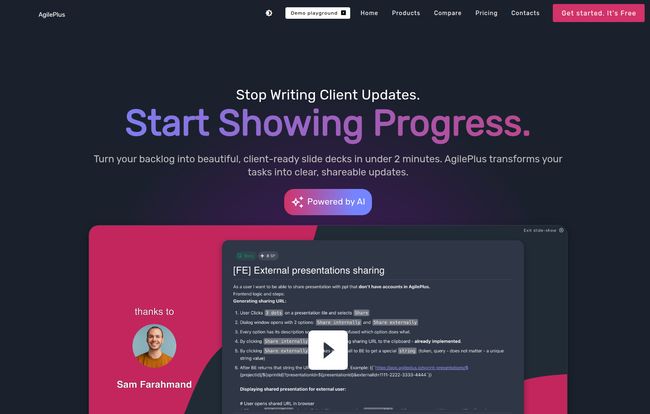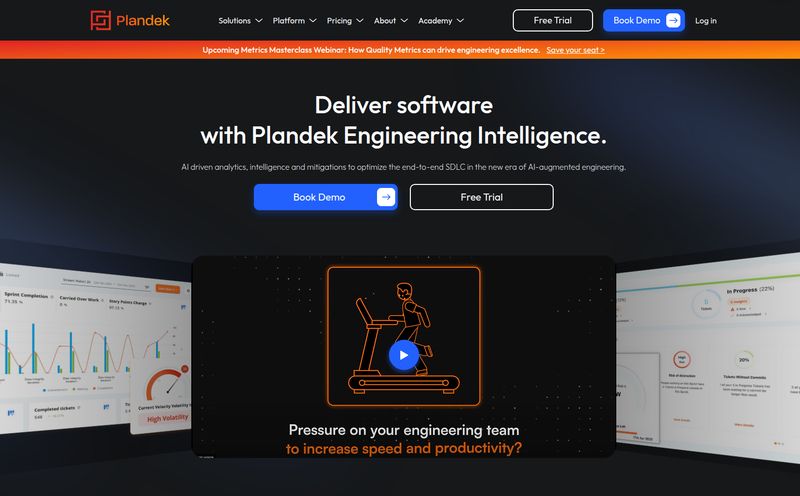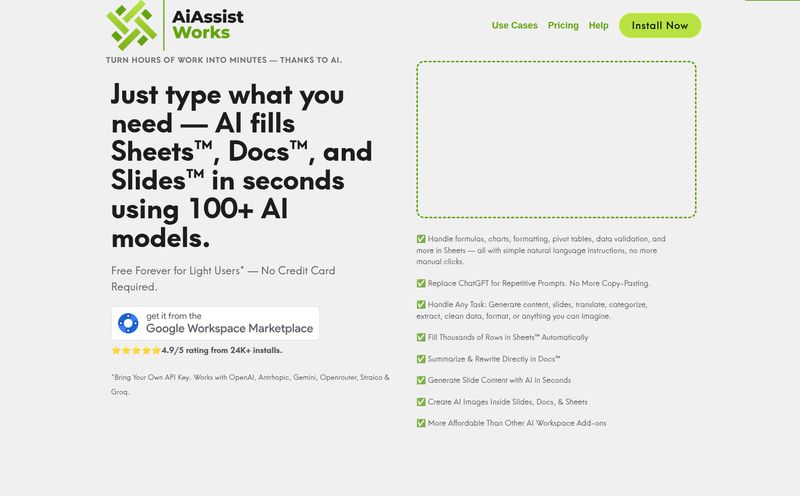Let’s have a little heart-to-heart. You, me, and the ghost of a dozen forgotten SaaS subscriptions. You know the drill, right? You’ve got Jira or Asana for your tickets. Slack is pinging away, a constant river of communication (and cat GIFs). Then there’s Miro or Mural for whiteboarding sessions. And when it's time for the sprint demo, you’re frantically cobbling together a PowerPoint, praying the data you pulled is even correct.
It’s… a lot. I’ve been managing digital projects and SEO campaigns for years, and my toolbar has more icons than a decorated general's uniform. Each tool is great at its one thing, but switching between them feels like trying to cook a gourmet meal using utensils from five different kitchens. It’s inefficient, it’s expensive, and honestly, it’s just plain exhausting. It's what I call 'tool sprawl', and it's a productivity killer.
So when I stumbled upon a platform called AgilePlus, which boldly claims to be an all-in-one solution for Agile ceremonies, my inner skeptic raised a well-groomed eyebrow. Another one? But then I looked closer. And folks, I think they might actually be onto something.
What Exactly is this AgilePlus Thing?
At its core, AgilePlus isn’t trying to reinvent the wheel. It's trying to put all four wheels, the engine, and the steering wheel into one single, cohesive vehicle. It’s a team collaboration platform specifically designed to house all those pesky-but-necessary Agile ceremonies under one roof. Think daily check-ins, backlog refinement, retrospectives, and even sprint presentations.
The target audience is pretty clear: Scrum Masters who are tired of being part-time tech support, Product Owners who need a clear view of progress, and Agile teams who just want to get work done without logging into six different apps before their first coffee. It’s built on a simple, but powerful premise: save time and cut down on tool costs. A bold claim in a world where new project management tools pop up faster than dandelions in spring.
<A Deeper Look at the AgilePlus Features
Alright, so the big promise is a unified platform. But what does that actually mean in practice? Let’s break down the main features they’re offering, based on what I could see.
Making Sprint Demos Less of a Panic Attack
I can’t be the only one who gets a cold sweat an hour before the sprint demo. Pulling stats, grabbing screenshots, creating slides… it's a scramble. AgilePlus has a built-in presentation generator. It seems to pull progress directly from your team's tasks to auto-generate slides. This could be a game-changer. Imagine turning a two-hour slide-building marathon into a 15-minute review and export. That's more time for polishing the actual presentation, or you know, breathing.
Daily Check-ins That Aren’t Just for Show
The daily stand-up can sometimes feel like a ritual we do just because the Agile manifesto told us to. The team check-in feature in AgilePlus gives a space for daily notes and status updates. It seems to be a more asynchronous-friendly way of handling things, which is fantastic for remote or hybrid teams. It provides a persistent record, so you don't have that "what did we talk about yesterday?" moment of confusion.
<
Visit AgilePlus
Taming the Beast of Backlog Refinement
Ah, refinement. The meeting that can either be incredibly productive or a one-way ticket to nap-town. AgilePlus includes tools for story point estimation and discussion right in teh platform. I saw mentions of story points and estimation tools, which means no more holding up fingers or using a janky third-party planning poker app. Keeping the backlog, the discussion, and the estimation in one place? Yes, please.
Retrospectives that Actually Lead to Action
A good retrospective is worth its weight in gold. A bad one is just a glorified complaining session. This platform has built-in tools for retros, including discussion prompts, voting on ideas, and creating concrete action items. This structure is so important. It turns vague feelings of "this sprint was chaotic" into actionable steps like "we will dedicate the first hour of the sprint to detailed task breakdown." That’s how teams actually improve.
Okay, So What's the Damage? A Look at the Pricing
This is where the rubber meets the road for most teams. An amazing tool is useless if you can't afford it. AgilePlus has a pricing structure that seems pretty smart and accessible. I've laid it out in a simple table.
| Plan | Price | Key Features |
|---|---|---|
| Free | Free | Up to 10 users, 1 project, 1GB/user storage, unlimited core ceremony sessions, 1 integration. |
| Standard | $15 /user/month | 11-100 users, 50 projects, 3GB/user storage, AI features, up to 3 integrations. |
| Pro | $25 /user/month | 101-250 users, unlimited projects, 5GB/user storage, unlimited integrations. |
| Enterprise | Contact for Price | 250+ users, advanced features, custom ceremonies, unlimited everything. |
My take? The Free plan is incredibly generous. For a small team or a startup just finding its footing, getting all the core ceremony features for up to 10 people is a fantastic way to get started without financial commitment. The Standard plan at $15/user feels very competitive, especially when you consider it might replace two or three other subscriptions that cost $8-12/user each.
<The Good, The Not-So-Good, and the Realistic View
No tool is perfect. Let's be real. It’s important to look at this with open eyes.
What I'm Genuinely Excited About
The biggest win here is the potential for focus. Having everything in one place just reduces the cognitive load on the entire team. The time saved from app-switching and data-wrangling is real. Their landing page says "10x quicker, 2x cheaper," and while "10x" is a classic marketing claim, I can absolutely see how it would be significantly quicker. The cost savings are also a no-brainer if you're currently paying for a separate whiteboard tool, presentation software, and maybe even a premium survey tool for retros.
Some Things to Keep in Mind
However, this approach isn't without its potential pitfalls. For one, you're putting all your eggs in one basket. If AgilePlus has an outage, your entire workflow for ceremonies is down. Second, getting a team to adopt a new platform can be like herding cats. There will be resistance, especially from people who love their specialized tools. Some might argue that a dedicated tool like Miro will always have more advanced whiteboarding features. And they're probably right. The question is, do you need that advanced functionality, or is the 80/20 rule good enough if it means better integration?
"The effectiveness of any tool, especially an all-in-one platform, depends entirely on how well the team embraces it. It's as much a cultural shift as it is a software change."
So, Who is AgilePlus Really For?
In my opinion, AgilePlus hits a sweet spot for a few key groups:
- Startups and Small-to-Medium Teams: Especially those who are budget-conscious and want to establish good Agile habits from the start without a complicated and expensive toolchain. The free and standard tiers are perfect for this.
- Teams Suffering from Severe Tool Fatigue: If your team is audibly groaning about having to use yet another app, consolidating with AgilePlus could be a massive morale and productivity boost.
- Pragmatic Scrum Masters and Product Owners: If your goal is efficiency and clear communication over having the absolute-most-powerful-version of every single niche tool, this platform is built for you.
It might be a harder sell for massive enterprises already deeply entrenched in complex ecosystems like Jira with a hundred plugins, or for teams of power-users who need the absolute pinnacle of features in one specific area.
<FAQs About AgilePlus
- Is AgilePlus a full replacement for Jira or Asana?
- From what I can tell, it's more focused on the ceremonies and collaboration around the work. While it has task-like elements for generating presentations, it doesn't seem to be a full-blown ticket and project management system. It's designed to work with or streamline the processes that feed into those systems. The website mentions integrations, so it likely connects to them.
- How steep is the learning curve?
- The UI looks clean and the promise of getting started in "under 20 minutes" suggests they've prioritized user-friendliness. The challenge won't be learning the tool itself, but changing the team's habits.
- Can I really try AgilePlus for free?
- Yes. They have a permanent free plan for teams of up to 10 users, which includes access to all the core ceremony and collaboration features. It's a great way to test it out with a small project.
- What kinds of integrations does AgilePlus offer?
- The pricing tiers mention a growing number of integrations as you go up. While the specifics aren't listed in detail in the images, you'd expect to see connections to popular tools like Jira, Slack, Trello, and GitHub. You'd have to check their site for the most current list.
- Is my data secure?
- Any modern SaaS platform lives and dies by its security. While not explicitly detailed here, standard security practices like data encryption and secure cloud hosting are table stakes. For enterprise clients, there are likely more advanced security and compliance features available.
My Final Takeaway
I'm cautiously optimistic. I’ve seen dozens of tools promise to be the one-stop-shop, but AgilePlus feels different. It’s not trying to be everything to everyone. It has a clear, defined focus: making Agile ceremonies less painful and more productive by bringing them together. It’s a specialist in being a generalist, if that makes any sense.
For teams drowning in subscriptions and context-switching, this platform isn't just a nice-to-have; it could be a liferaft. The value proposition is strong, the pricing is fair, and the problem it solves is one that I, and probably you, feel on a daily basis. It’s definitely worth spinning up a free account for your next project to see if it brings a little more zen to your sprints.
Reference and Sources
- AgilePlus Official Website: https://agileplus.io/



